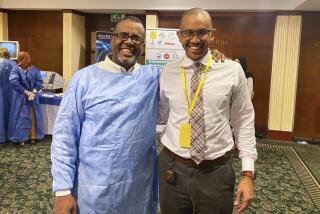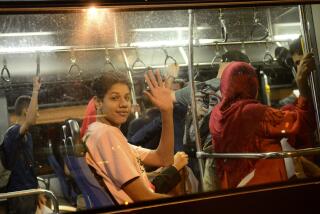Resentment Is Festering in ‘Little Falloujas’
- Share via
BUHRIZ, Iraq — His Charlie Battery was dug in against as many as 50 insurgents, Capt. Matt Davenport remembers, and the volleys of rocket-propelled grenades and bursts of machine-gun fire were nonstop. At one point in the two-day firefight, he recalls, “there was an explosion every five seconds.”
The battle was fierce enough that it could have occurred at the height of this spring’s siege of Fallouja, a city that has become notorious worldwide as a hub of resistance to American and allied forces. But the fight came just a few weeks ago, in this agricultural town northeast of Baghdad.
There is only one Fallouja, but, unfortunately for U.S. forces and their allies, seething towns such as Buhriz dot Iraq’s vast “Sunni Triangle.” They are home to traditional tribal populations embittered by the U.S.-led forces in their country -- and suspicious of an Iraqi government installed by foreigners.
Harnessing these “little Falloujas” back into the fold of civil Iraqi society is one of the great challenges facing the new government and its U.S. allies.
A cycle of violence, distrust and radicalization has festered for a year in Sunni Iraq and will not go away easily.
The U.S. strategy has followed a variant of the carrot-and-stick approach -- crushing armed opposition but also offering millions in development funds to cooperative local governments.
“There’s an inverse relationship between successful projects and American casualties,” said Col. Dana Pittard, who heads the 1st Infantry Division brigade that patrols Buhriz and the rest of Diyala province. “We’re going to be fighting our way out of here if that money dries up.”
In the case of Buhriz and other troubled Sunni towns, town leaders call U.S. troops a provocation and demand that they stay away.
“That is exactly what should be done here,” Buhriz Mayor Awf Abdul Rida Ahmad said when asked if the Americans should stay away and leave matters to town police. “The people here are very peaceful, and all they want is stability and peace of mind.”
But American officials have already rejected the possibility of more security arrangements like those in Fallouja, where U.S. forces agreed to pull out of the city in April and turn it over to a collection of former Iraqi army officers with close ties to the insurgents. Fallouja has since become a no-go zone for U.S. Marines and a sanctuary for insurgent militancy, commanders acknowledge.
“One thing is for sure: It’s not a template for the future,” Lt. Gen. Thomas F. Metz, operational chief of U.S.-led troops in Iraq, said of the Fallouja blueprint. “It’s disappointing.”
It is no coincidence that the most problematic towns are those where the Sunni-dominated Baath Party of former dictator Saddam Hussein is still held in high esteem and where many people prospered under Hussein. In insulated towns such as Buhriz, many regard the now-dissolved Baath structure as a kind of benevolent dictatorship that protected the interests of the minority Sunni Muslim population against rival Shiites and others.
“The old Baathists are everywhere in Iraq .... What do the Americans want to do with them?” said Ahmad, a 44-year-old agricultural engineer who was manager of Buhriz’s irrigation plant during Hussein’s regime.
“The Baathists here are very good people. They managed to maintain security and order right after the fall of the regime. They organized checkpoints in the town and prevented any theft or crime.”
The mayor doesn’t say so, but the former Baathists of Iraq helped organize something else: an anti-occupation rebellion that has fought the U.S. military to a standstill and thwarted the Bush administration’s ambitious plans for rebuilding the country. Black-clad Fedayeen Saddam militiamen were the fanatical regime enforcers -- and the early foot soldiers of the armed opposition.
The insurgency has found fertile ground in places such as Buhriz, a town of 40,000 or so. Here, as elsewhere, armed resistance has become entangled with anti-American nationalism, religious militancy and, in some cases, U.S. officials say, fighters from other Arab nations.
U.S. Army sweeps that have resulted in tens of thousands of arrests nationwide -- including more than 200 in Buhriz, the mayor said -- have fanned the resentment.
One especially disturbing trend, from the U.S. standpoint, is the intermingling of conservative religious ideology with the insurgency. Fighters are regularly acclaimed as mujahedin, or holy warriors, their exploits celebrated in teahouses, living rooms and mosques.
The conservative Salafi, Wahhabi and Sufi teachings that have proliferated in Sunni Iraq since the fall of the regime last year provide a moral basis for the armed opposition.
“Yes, people’s commitment to religion has increased, since religious scholars are so often condemning the occupiers as being the cause of all our troubles,” a bearded man in tribal garb, who gave his name as Abu Mohammed, said as he walked near one of the main mosques here. “Our religious teachings call for fighting the occupiers, especially when they are non-Muslim.”
In hard-core Sunni enclaves such as Buhriz -- riverside towns of palm groves, mud huts, concrete-block houses and the ubiquitous minarets of mosques -- there often appears to be absolutely no meeting of the minds between the Americans and the Iraqis.
Take, for instance, the running battles here in the middle of June. There is one point of accord -- it was a vicious confrontation that caused massive damage to Buhriz and left more than a dozen Iraqis dead and scores injured. One U.S. soldier was killed in the fighting.
Among the dead was Ali Hussein Septi, a man whom the U.S. Army labeled a dangerous insurgent cell leader. The Army said he was shot in the abdomen during a predawn raid on his house June 17, an incident that apparently ignited the tensions. Septi fired an AK-47 at U.S. troops, medical efforts failed to save him, and he died in U.S. custody, the Army said.
“Septi was one of two insurgent cell leaders in Buhriz,” Pittard said.
Residents said Septi was a harmless lunatic and former prisoner of war in Iran.
The other purported resistance leader, known by U.S. forces as Abu Zooz, is described here as an unemployed grocer who stopped by City Hall recently looking for work as a night guard.
Mayor Ahmad said he recently summoned Abu Zooz and other alleged insurgent chiefs to his office to inform them of the Army’s allegations, which have also circulated in press accounts in nearby Baqubah.
“I told them ... ‘The newspapers have made terrorist leaders out of you,’ ” the mayor said. “They had tears in their eyes when they heard about that.”
The day after Septi’s arrest, U.S. forces visited City Hall to talk of much-needed water and redevelopment projects.
“We were very delighted and happy, and the rest of Buhriz people were similarly happy to hear the good news,” Ahmad recalled. He complained that “not a penny” had been invested in the town despite many needs, especially potable water.
But reconciliation wasn’t in the cards on this day.
The Army said its forces were attacked with rocket-propelled grenades and small-arms fire. Witnesses in Buhriz said U.S. forces withdrew suddenly after discovering a suspected car bomb. It was later determined that it contained no explosives, said the mayor, who added that the car belonged to a nephew of his who was a police officer.
At any rate, the Army later returned in force to positions in town, and fierce fighting soon erupted.
“They were launching RPGs at us all day,” Davenport recalled. “It was continuous fire.”
Residents said U.S. forces opened fire without provocation, causing extensive damage in the town and killing more than a dozen civilians.
Sheik Mehdi Salih Jeghaidi, a 52-year-old town council member, accused U.S. forces of using “human shields” as they took position in civilian houses.
“They were keeping families inside their houses ... just to make sure that the attackers might not fire at them when they were with Iraqi families,” Jeghaidi said.
The Americans said their fire was precise and the Army avoided use of artillery to prevent collateral damage. Most of the destruction evident in the town came from badly aimed insurgent mortar rounds and grenades, the Army said. “The insurgents are completely irresponsible with their fire,” Pittard said.
According to the mayor, 13 residents were killed and 57 were injured in June’s battles. The Army did not dispute those numbers but blamed the deaths on enemy fire and said 19 insurgents were killed and scores wounded.
U.S. commanders cite indications that word of the fighting in Buhriz may have attracted foreign militants, including followers of Abu Musab Zarqawi, the Jordanian-born terrorist chief said to be operating in Iraq. But locals say the only foreigners evident were the Americans.
“Our mujahedin have no relation whatsoever with anybody from outside the town,” said Muthanna Azzawi, a 40-year-old retired corporal in the defunct Iraqi army.
Things have calmed somewhat in Buhriz. An Army reconstruction team returned in late June and was not attacked -- a promising sign, all agree.
The Army has agreed to let Iraqi forces police the town, but -- unlike the security arrangement in Fallouja -- soldiers have maintained the right to enter whenever it is deemed necessary.
In Baqubah on June 22, officers of the 1st Infantry Division paid tribute to Pfc. Jason Nathanial Lynch, a 21-year-old gunner from St. Croix, U.S. Virgin Islands, who was killed in a firefight four days earlier in Buhriz. A somber Davenport accepted condolences for his “best gunner” but sounded a pessimistic note about the town.
“If we go in there right now, it would be the same thing,” he said as he stared toward the rifle and boots arrayed around the private’s memorial. “Buhriz is just a tough place.”
Times staff writer McDonnell reported from Baqubah and special correspondent Ahmed from Buhriz.
More to Read
Sign up for Essential California
The most important California stories and recommendations in your inbox every morning.
You may occasionally receive promotional content from the Los Angeles Times.










